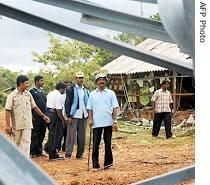2006年VOA标准英语-Sri Lanka Jets Strike at Rebels(在线收听)
By Patricia Nunan
New Delhi
17 October 2006
 Head of Tamil Tiger political wing, S. P. Thamilselvan (2R) inspects damage to their radio transmitting station in Kokkavil, October 17, 2006 |
||
-----
Defense officials say that air force jets pounded a suspected Tamil Tiger rebel military base in the northeastern district of Trincomalee, after the suicide bombing killed as many as 100 sailors and others.
A pro-rebel Internet site charges the air strikes killed two children and destroyed the homes of nine civilians. Neither statement can be independently confirmed.
Officials blame the Tamil Tigers for Monday's suicide bombing, in which a truck packed with explosives was driven into a convoy of buses carrying unarmed sailors. It was one of the most deadly incidents in months of growing hostilities between the rebels and the government, which threaten to return the country to all-out war.
On Wednesday, police are expected to exhume the bodies of 15 aid-workers, among 17 who were massacred in August, following weeks of fighting between the government and the rebels in the northeastern town of Muttur.
All of the victims worked for the French organization Action Against Hunger, known as ACF. Most were ethnic Tamils. And most were found lying face down in the group's compound, having been shot in the back of the head, execution-style.
ACF officials say they will be at the exhumations, as will other international observers. Australian forensic experts are to help conduct post-mortem examinations, which could reveal evidence that point toward the killers, such as the type of ammunition used.
"Perhaps, but in this kind of situation we have to be very cautious because it can be manipulated," said Benoit Miribel, ACF's general director. "So you never know who has used these arms. It could be one element. But the key factor to know the truth will be through the eye-witnesses."
The investigation into the killing of the aid workers is one of 14 cases of gross human rights violations to be considered by a commission formed by President Mahinda Rajapakse.
Some have doubts as to whether the new commission will lead to the prosecution of those who have committed abuses. Paikiasothy Saravanamuttu is an analyst with the Center for Policy Alternatives.
"The point is simply this: presidential commissions have recommendary [recommendation] powers," he said. "Indictment, prosecution, etc, go back to the existing national procedures and institutions, which if they were doing their job properly in the first instance, would not require separate presidential commissions to investigate these."
The former head of the a group of international ceasefire monitors, the Sri Lanka Monitoring Mission, in August blamed the massacre on government security forces. Officials vehemently denied the assertion, and criticized the SLMM for releasing its findings before the government investigation.
The Tamil Tigers and the government signed a ceasefire in 2002, meant to bring an end to more than two decades of ethnically fueled civil war. But with about 2,000 people killed in isolated fighting and tit-for-tat violence so far this year, many in Sri Lanka say the war has resumed.